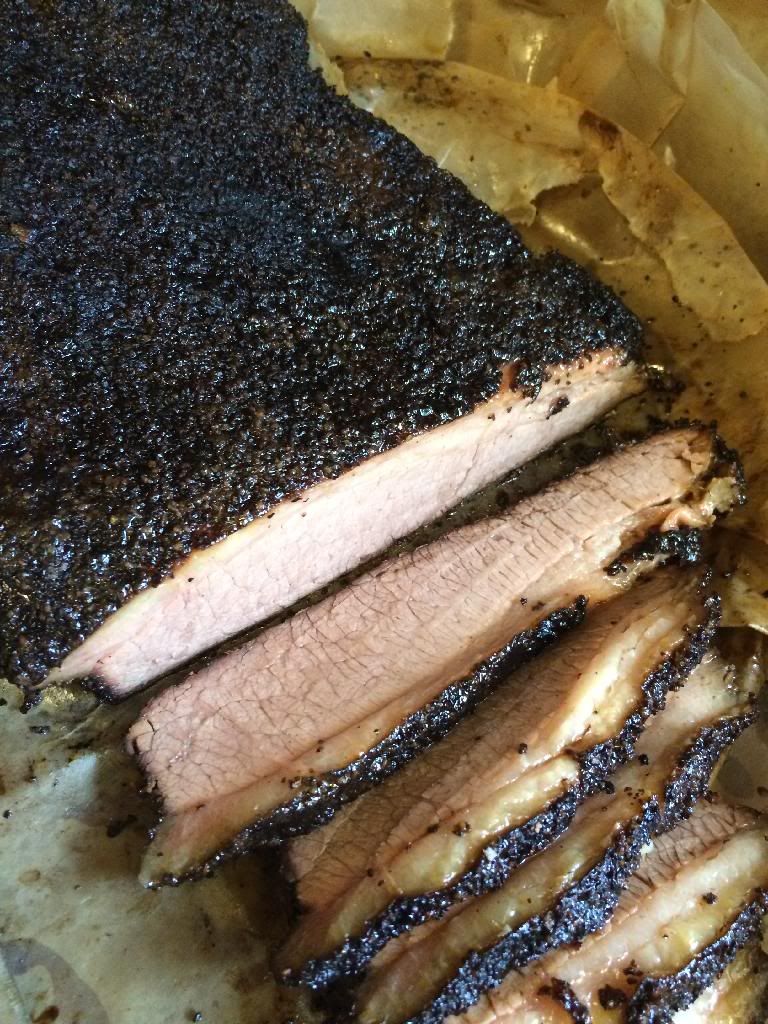PeterD
TVWBB Super Fan
Hi all,
I've done three more packers recently and I just can't get them perfect, whether it's hot-and-fast or low-and-slow. I generally have the time and patience to do a low and slow, and with Comp K and a Stoker, I have the timing down well. Everything goes great until the stall. Once it breaks the stall and starts slowly climbing upwards, I'm monitoring my meat temps regularly from the stoker probe. When it hits about 180-185 I take the lid off and start checking for tender and that's when things go haywire.
I'll have perfect tender on the main part of the packer, where the point goes over the flat, and in the flat itself near the junction of the deckle. But the main part of the flat will rapidly overcook to become a crumbly, dry mess when I slice. This means about a third of the brisket is unusable, but the point and underrunning flat are generally quite tasty.
I have a 2008 18" WSM (not the newer 18.5) and an original Stoker that's about 4 years old now. One probe goes into the meat around the deckle, inserted from the side and the other is on a clip about an inch off the grate. Now here's another problem: I have checked both pit and meat probes in ice water and boiling water and they're good to within a couple of degrees of each other, and both read close to where they should be. I also have a Thermapen (about 8 years old and recently recalibrated), and it, too, reads about the same as the Stoker probes. BUT. When the Stoker is reading 180 in the meat, the Thermapen is up around 210 in the flat. Hence the crumbly mess.
Where should I be inserting the meat probe? Yeah, yeah, I know....."into a warm moist place" as my buddy would say. But seriously....Am I monitoring the wrong place? What else would account for this happening? I've put foil under the farthest end of the point to shield the thinnest end of the meat from the gap between the water pan and the barrel's edge, and if it's a bigger cut, I'll tuck the thin end under the grill handle. If it's a 14-15 pounder it'll be draped over three foiled bricks on the grate. Since I'm only usually cooking for a few people, I generally cook 10-12 pounders after trimming.
Whenever I go to the name-brand Q joints even the furthest outside end bits are juicy and tender; I've never achieved that in about 30 cooks. Any idea what I'm doing wrong or what I can change up to get the flat that succulent but keeping the point and flat at the back end perfect?
Thanks in advance.
I've done three more packers recently and I just can't get them perfect, whether it's hot-and-fast or low-and-slow. I generally have the time and patience to do a low and slow, and with Comp K and a Stoker, I have the timing down well. Everything goes great until the stall. Once it breaks the stall and starts slowly climbing upwards, I'm monitoring my meat temps regularly from the stoker probe. When it hits about 180-185 I take the lid off and start checking for tender and that's when things go haywire.
I'll have perfect tender on the main part of the packer, where the point goes over the flat, and in the flat itself near the junction of the deckle. But the main part of the flat will rapidly overcook to become a crumbly, dry mess when I slice. This means about a third of the brisket is unusable, but the point and underrunning flat are generally quite tasty.
I have a 2008 18" WSM (not the newer 18.5) and an original Stoker that's about 4 years old now. One probe goes into the meat around the deckle, inserted from the side and the other is on a clip about an inch off the grate. Now here's another problem: I have checked both pit and meat probes in ice water and boiling water and they're good to within a couple of degrees of each other, and both read close to where they should be. I also have a Thermapen (about 8 years old and recently recalibrated), and it, too, reads about the same as the Stoker probes. BUT. When the Stoker is reading 180 in the meat, the Thermapen is up around 210 in the flat. Hence the crumbly mess.
Where should I be inserting the meat probe? Yeah, yeah, I know....."into a warm moist place" as my buddy would say. But seriously....Am I monitoring the wrong place? What else would account for this happening? I've put foil under the farthest end of the point to shield the thinnest end of the meat from the gap between the water pan and the barrel's edge, and if it's a bigger cut, I'll tuck the thin end under the grill handle. If it's a 14-15 pounder it'll be draped over three foiled bricks on the grate. Since I'm only usually cooking for a few people, I generally cook 10-12 pounders after trimming.
Whenever I go to the name-brand Q joints even the furthest outside end bits are juicy and tender; I've never achieved that in about 30 cooks. Any idea what I'm doing wrong or what I can change up to get the flat that succulent but keeping the point and flat at the back end perfect?
Thanks in advance.




